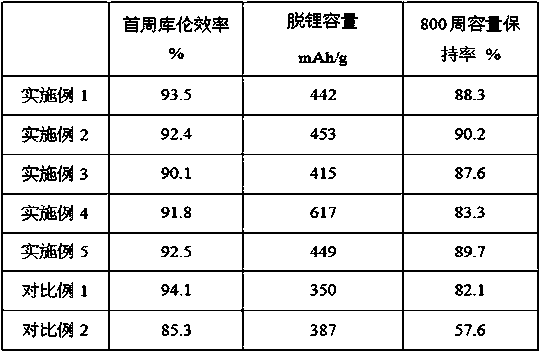Preparation method of high-performance silicon carbon-graphite composite negative electrode material for lithium ion batteries
A technology of silicon-carbon composite materials and lithium-ion batteries, applied in the preparation/purification of carbon, nanotechnology for materials and surface science, battery electrodes, etc., can solve the problems of silicon-carbon negative electrode cycle performance failure, nano-silicon easy to fall off, Weak adhesion and other problems, to achieve the effect of easy industrial production, low cost and long cycle life
- Summary
- Abstract
- Description
- Claims
- Application Information
AI Technical Summary
Problems solved by technology
Method used
Image
Examples
Embodiment 1
[0028] ① Dissolve 100g pitch in 1000g diesel solution to make a solution, then add 100g 100nm nano silicon powder (purity 99.9%) and mix uniformly to make a dispersion; ②Put the dispersion into a vacuum-high pressure impregnation reactor and add 1800g 15μm flake graphite (Carbon content>99.0%), first immerse in a vacuum state for 0.5h (vacuum degree is -80kPa), then pressurize to 4.0MPa (pressurized gas is nitrogen), immerse for 4h, and vacuum dry at 120℃ to obtain silicon-carbon composite material Silicon-carbon composite material precursor; ③Transfer the silicon-carbon composite material precursor to the spheroidization equipment to obtain the spheroidized composite material precursor; ④The spheroidized composite material precursor is solid-coated with 5% pitch to obtain a coating Spheroidizing precursor 3; ⑤ Place the precursor 3 in a high-purity nitrogen atmosphere furnace for carbonization (flow 2000L / h), the heating rate of the carbonization furnace is 3°C / min, the tempera...
Embodiment 2
[0030] ① Dissolve 100g of chitosan in 1000g of anhydrous ethanol solution to prepare a solution, then add 100g of 30nm nano silicon powder (purity 99.9%) and mix uniformly to prepare a dispersion; ②Put the dispersion into a vacuum-high pressure impregnation reactor and add 1800g 15μm flake graphite (carbon content>99.0%), first immerse in a vacuum state for 0.3h (vacuum degree is -80kPa), then pressurize to 5.0MPa (pressurized gas is helium), immerse for 3h, and vacuum dry at 130°C Obtain the silicon-carbon composite material precursor; ③The silicon-carbon composite material precursor is transferred to the spheroidization equipment to obtain the spheroidized composite material precursor; ④The spheroidized composite material precursor is solid-coated with 6% phenolic resin , The coated spheroidizing precursor 3 was prepared; ⑤The coated spheroidizing precursor was carbonized in a high-purity nitrogen atmosphere furnace (flow rate 2000L / h), the heating rate of the carbonization fu...
Embodiment 3
[0032] ① Dissolve 100g phenolic resin in 1000g acetone solution to prepare a solution, then add 100g 30nm nano silicon powder (purity 99.9%) and mix uniformly to make a dispersion; ②Put the dispersion into a vacuum-high pressure impregnation reactor and add 1800g 15μm flakes Graphite (carbon content>99.0%), first immerse and react under vacuum for 0.5h (vacuum degree is -80kPa), then pressurize to 2.0MPa (pressurized gas is argon), immerse and react for 5h, vacuum dry at 150℃ to obtain silicon carbon Composite material silicon-carbon composite material precursor; ③Transfer the silicon-carbon composite material precursor to the spheroidization equipment to obtain the spheroidized composite material precursor; ④The spheroidized composite material precursor is solid-coated with 5% pitch to prepare Coating the spheroidizing precursor 3; ⑤ Place the precursor 3 in a high-purity nitrogen atmosphere furnace for carbonization (flow rate 2000L / h), the heating rate of the carbonization fu...
PUM
 Login to View More
Login to View More Abstract
Description
Claims
Application Information
 Login to View More
Login to View More - R&D
- Intellectual Property
- Life Sciences
- Materials
- Tech Scout
- Unparalleled Data Quality
- Higher Quality Content
- 60% Fewer Hallucinations
Browse by: Latest US Patents, China's latest patents, Technical Efficacy Thesaurus, Application Domain, Technology Topic, Popular Technical Reports.
© 2025 PatSnap. All rights reserved.Legal|Privacy policy|Modern Slavery Act Transparency Statement|Sitemap|About US| Contact US: help@patsnap.com


